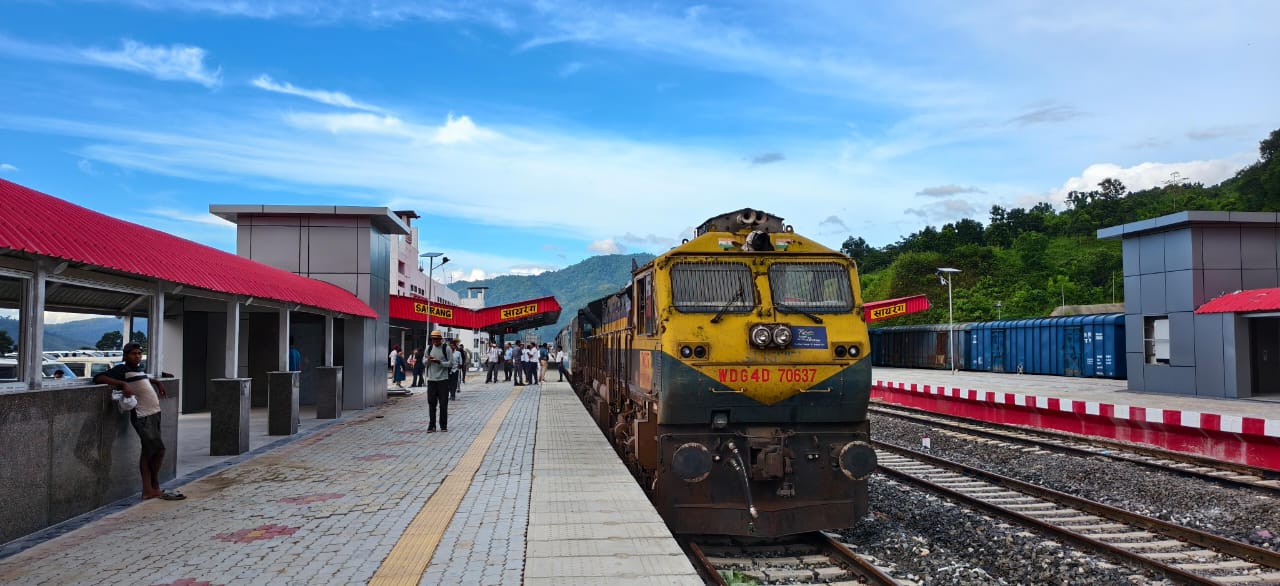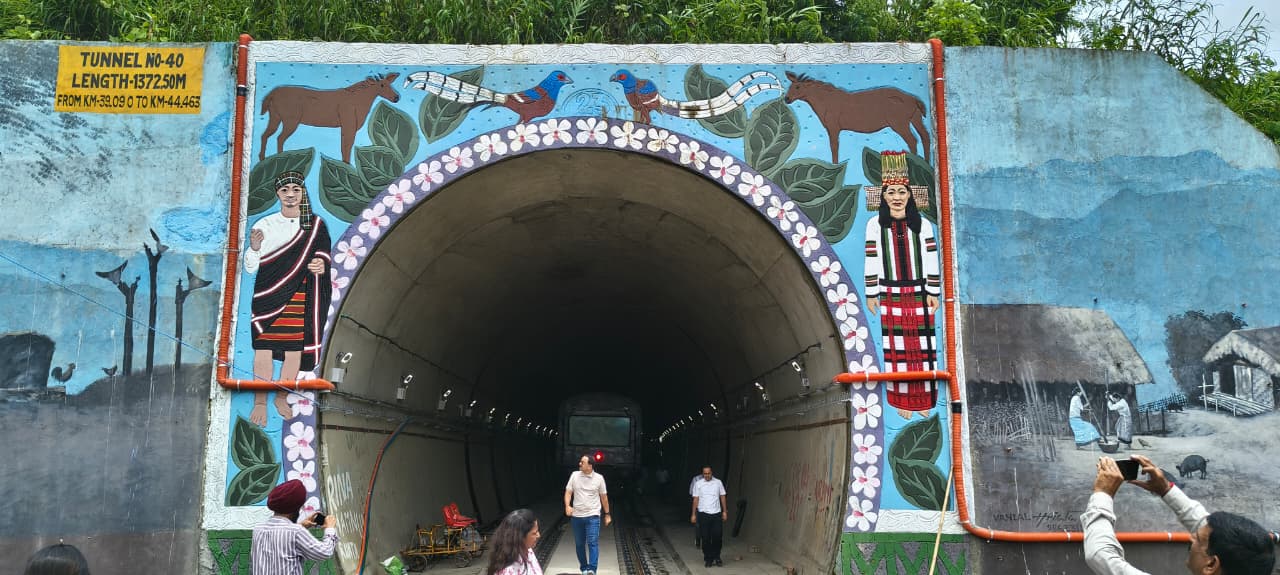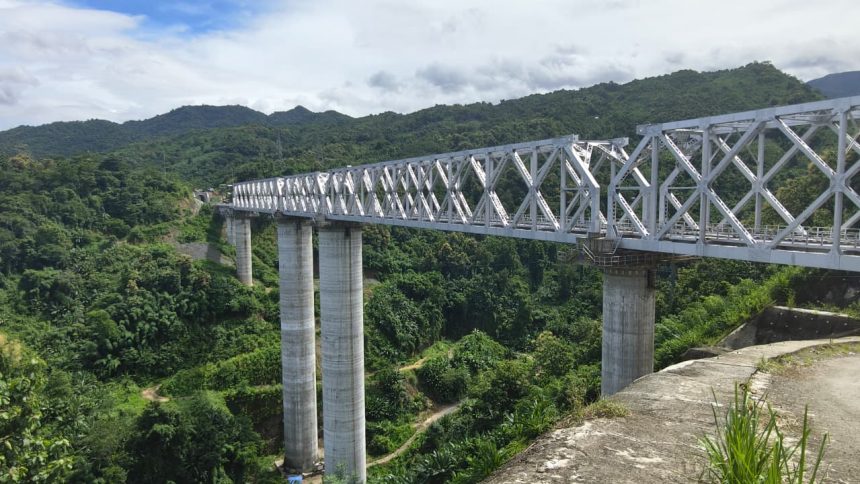Ground Zero:
Mizoram’s capital Aizawl is set to become the fourth capital city in the Northeast to be connected with India’s national railway network, with the 51.38-km Bairabi–Sairang New Railway Line Project scheduled for inauguration in September, officials said on Wednesday.
Executed under the Act East Policy, the project stands as a symbol of progress and national integration. It comprises 45 tunnels with a total length of 15 km. The longest tunnel stretches 1.5 km, while the alignment includes 151 bridges 88 minor bridges, 10 ROBs/RUBs, and 55 major bridges with a combined length of 11.8 km.
Among them is the iconic Bridge No. 196, or the Kurung Bridge, which at 114 meters is the second-tallest pier bridge in India, 42 meters higher than the Qutub Minar. It is also the second-highest bridge in the Northeast and was completed in just five years.
Chief Engineer Railways, Vinod Kumar, who led the construction in Mizoram, said his decade-long experience on Jammu and Kashmir’s Udhampur–Srinagar–Baramulla Rail Link (USBRL) project helped him overcome similar challenges.
“It is a capital connectivity project, and will link Mizoram with the national network. It will be the fourth northeastern capital after Guwahati, Agartala and Itanagar to be connected to Indian Railways’ grid,” he told Rising Kashmir.
Bairabi in Kolasib district, near the Assam border, has so far been the only railhead in Mizoram. Sairang, a satellite town of Aizawl, lies around 20 km from the capital.

Photo Irfan Yattoo
Er Kumar said the new line will drastically reduce travel time between Guwahati and Aizawl from nearly 18 hours by road to less than 12 hours by rail. Fares are expected to be around Rs 450, making travel affordable for students, traders, and patients.
“The project was sanctioned in 2008-2009 and was declared a national project due to its significance. The survey and land acquisition followed, and Prime Minister Narendra Modi laid its foundation stone on November 29, 2014. Construction began in 2015-16,” he said.
Er Kumar added that the project was completed in June 2025 after years of day-and-night work. “We initially constructed 48 tunnels, but later combined three, leaving 45 tunnels with a total length of 15.8 km. Nearly 31 percent of the alignment passes through tunnels,” he said.
The tunnels have been decorated with vibrant Mizo murals, blending modern engineering with local culture. Completed in four phases, the project received CRS clearance in June 2025, paving the way for operations.
In tunnels, women in colorful attire performing ‘Cheraw’, the traditional bamboo dance alongside drums and gongs.
“The walls and portals of the tunnels are adorned with images of villages, traditions, and cultural heritage,” he said.

According to Er Kumar, the project will significantly reduce transportation costs, boost tourism, trade and employment, and bring socio-economic growth to Mizoram and the entire Northeast.
On how his USBRL experience helped him northeast, Er Kumar said, the terrain is similar, but connectivity was a major issue here.
“Except for the Katra–Banihal stretch, USBRL had good access roads, link roads, but in Mizoram, we struggled at every stage. Even for the Katra–Banihal track, over 200 km of alternative road was constructed. But here, connectivity and weather were the biggest challenges,” he said.
Kumar explained that materials had to be transported via Assam’s National Highway, often affected by landslides and mudslides.
“NH-6, which runs parallel to the new railway line, remains Mizoram’s lifeline, connecting Silchar in Assam with Aizawl. The majority of essential supplies, including vegetables and construction materials, are transported along this route. However, road journeys are often arduous, with the highway frequently disrupted by landslides and blockages during the monsoon,” he said.
Er Kumar further said that while it currently takes around five hours to travel from Sairang to Bairabi by road, the new rail link is expected to reduce the journey to just 1.5 hours.”
Regarding the Iconic Chinar Bridge in J&K, he said that the bridge is still the highest bridge in India and is considered an engineering marvel, but this project too will be counted among the most difficult in Indian Railways.

Photo Irfan Yattoo
“These are shale hills mitti ke pahad. Work was only possible for 4–5 months a year, from November to March, as the prolonged monsoon made it impossible during April–October,” he said.
Er Kumar said that the access roads to the project site are narrow, prone to landslides, and too steep for big trucks. Materials had to be brought in smaller vehicles, sometimes pushed or pulled with chain-mounted cranes,” he said.
Northern Railway Chief Public Relations Officer Himanshu Shekhar Upadhyaya said the project will provide seamless connectivity to Mizoram’s capital.
“The new line links Aizawl with the rest of India, offering faster and more affordable transport options,” he said.
Upadhyaya said this will be the first train link for Mizoram. Thousands of workers, many of whom stayed at the site for years, worked relentlessly through unpredictable weather,” he said.
“‘It will not only ease pressure on NH-6 but also provide a safer, faster, and more reliable alternative for the people of Mizoram,’ he said.
Upadhyaya said it will save time and reduce transport costs for traders like us. Farmers will finally be able to send their produce outside the state more easily and will boost local tourism in the region.
Kapinjal Kishore Sharma, Chief Public Relations Officer (CPRO) of NFR, added that large cranes deployed for bridge girders had to be dismantled and reassembled at the site, while much of the construction material came from Assam, West Bengal, and other states.
“An extension of the line is already planned, with a Final Location Survey underway for a proposed 223-km railway line from Sairang (Aizawl) to Hbichhuah, on the Myanmar border,” he added.







